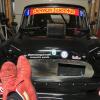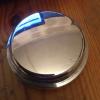Correct, but it was actually a PDWA (Pressure Differential Warning Actuator) first seen on certain Triumph models, and consisting only of a shuttle operating between two pressure chambers, one in each circuit, which when moved off centre by a pressure imbalance operated a switch. It contained no valves.
That system is in theory perfectly proportioned under all road conditions, as it is not using a limiter, optimised for a particular coefficient of friction. The later system, and indeed all such systems in hydrostatic hydraulic systems, are limiters, and if they are optimised for wet roads, there will not be the full possible rear braking on dry roads, while if they are optimised for dry roads, there will be severe rear wheel locking on wet roads. (There are added complications with changes in vehicle loading.) The only practical way of getting true proportioning is either designing it in by cylinder bore sizes or using a balance bar. The fancy Willwood valves are not proportioning valves, despite being called such, they are dual slope limiters. You can however get true proportioning (and PROPER ABS, not a bodge job!) in a power hydraulic system as in all large aircraft and certain Citroen and Rolls cars.
However I would really NOT like the diagonal split system on my car, as the Mini does not have negative scrub radius geometry at the front and therefore can be expected to be highly unstable in the event of a single failure. (That is one reason for Metro hubs being completely unsuitable on the Mini, the scrub radius is very different.) If I had one of these models I would feel obliged to do some testing, on a track, with solenoid valves wired into each circuit to, when energised, dump pressure back into the reservoir, to see what really happens. (I would do the same test on any radically altered brake configuration to check for adequate fluid displacement after first failure, as it is essential that if one circuit fails, the other will still operate within one single stroke of the pedal.
The later valve, which Moke Spider refers to is a limiter, with drawbacks as described. However it has a major safety feature built in. It is pressure in the FRONT circuit that closes the valve to block pressure to the REAR circuit, so if you have a FRONT failure, full pressure passes to the REAR to give you at least some chance of stopping. For that reason, it is vitally important to plumb the valve the correct way around, and people often ask about that. (Otherwise a relatively unimportant REAR failure would result in the FRONT limiting at about 450psi, or whatever the setting is, which would be less than typical normal braking, far less emergency,) The pictures in the Rover manual show all that is needed.
In my opinion the best configuration would be to use a PDWA in a split front/rear system with 0.5" rear cylinders because then you get proportional balance and pressure balance failure warning. But there is no scope for balance adjustment if you find it to be necessary, except by changing pads or shoes.



















